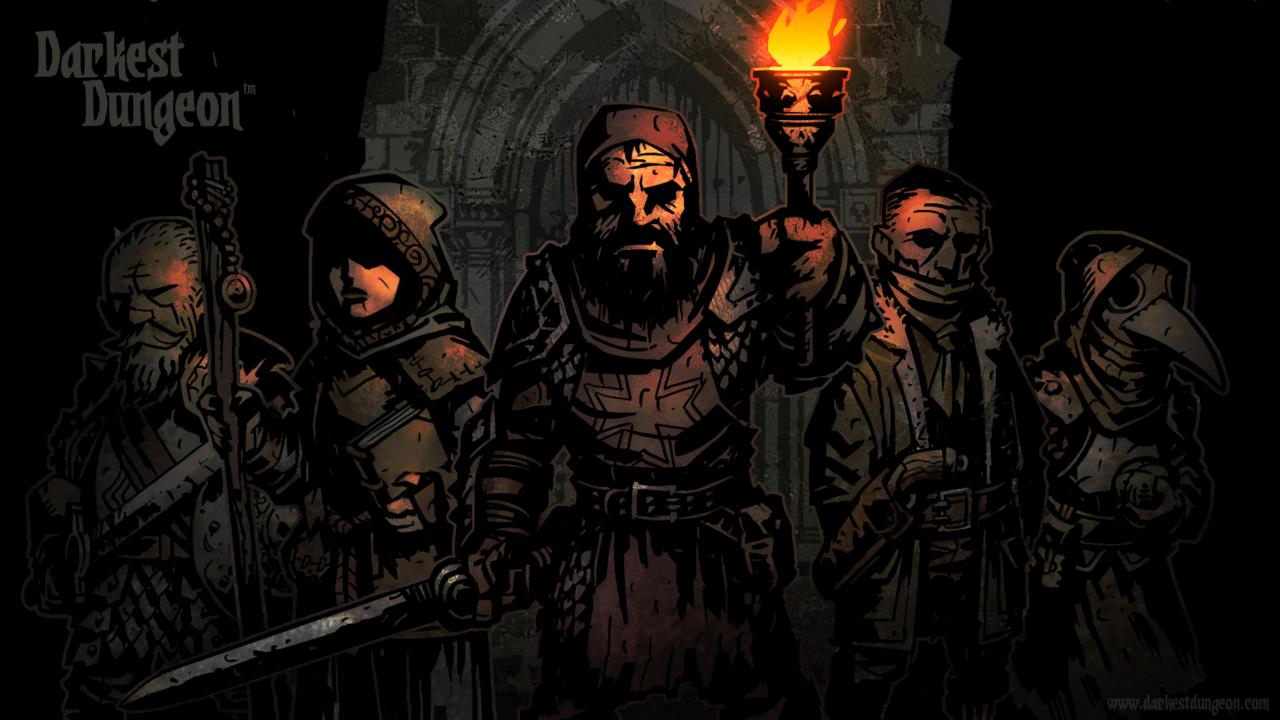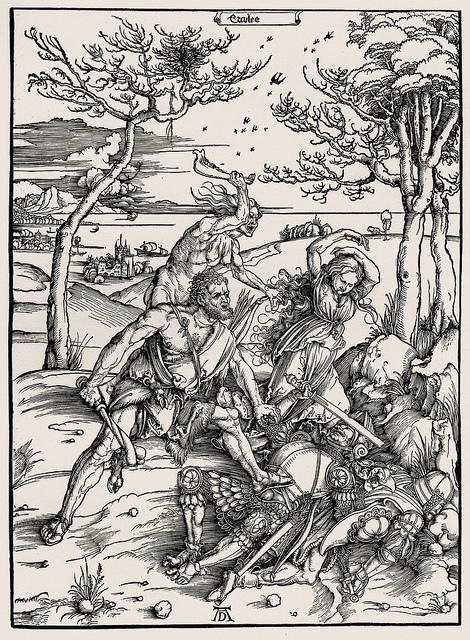How much can an artist say with a single image? I wonder this as I look at the title screen for Darkest Dungeon. On the surface, it's just a creepy mansion on a hill. But there's something particularly foreboding about this abode. The sky is the color of blood and the mansion itself sits so close to cliff's edge, it look as though it might tumble over it. Of course, I hear the howl of the wind and the call of crows; what eerie house would be complete without the sounds of impending doom? It's just the main title screen, but I already know so much before I've even played. Expectations have been set.
The turn-based battles that follow make good on that expectation. You lead a party of up to four adventurers from left to right, clearing dungeons of their mad denizens, and collecting the loot that remains. It's a setup you've seen before, but you wouldn't confuse Darkest Dungeon with any other game, in part due to the 2D characters that wander across the screen. If I had to find a proper comparison from another game, I'd probably choose Valiant Hearts, which had a similar layered look, and whose residents had a flatness to them. But Darkest Dungeon, true to its name, lurks in the shadows. The Gothic backgrounds, sharp animations, and gruesome closeups of two-dimensional violence are in service to a mansion that is clearly out to kill anyone who enters.

It's no accident that Darkest Dungeon's title screen strikes such a deep chord. I asked Darkest Dungeon creative director Chris Bourassa about that image, and he agreed that this first impression sets the tone for everything that follows. "We wanted to evoke a melancholic, mysterious, and lonely feeling with Darkest Dungeon," says Bourassa. "The opening image is a stark, hard-edged, and high contrast, meant to foreshadow the game's difficulty and overall uncompromising (read: always saving!) nature. The game is also set in an ambiguous time period, outside of history, which is why there are no landmarks or anything identifiable within view. We identify strongly with Gothic horror, and the 'ruined mansion' is a powerful symbol when it comes to quickly calling that up in a viewer."
The characters and visual layering were carefully considered as well. Bourassa wanted the game to look like the pages of an old manuscript illuminated by candlelight, worn and dirty. And indeed, all manner of visual elements look ravaged and ruined. Characters' skirts and loincloths are tattered; vegetation has been blown off of thatched roofs (that wind does sound strong); and dying trees seen in silhouette prick the sky with their branches. You feel the weight of centuries of torture every time you look at the screen.
Below: The Darkest Dungeon look, from genesis to completion.
Bourassa was careful not to burden players with too much emotional baggage, however. "The game is all about your characters' flaws and imperfections," says Bourassa, "so it was important that the art make that both obvious, and appealing. In order to avoid the game feeling totally oppressive, I added the tiniest bit of 'cuteness' to the style, both to increase the iconic quality of the characters, and to remind players that despite its overwrought subject matter, it is a game to be played and enjoyed."
Bourassa and I then delved further into the artistic nitty gritty--specific brushstrokes, the color story, and the artists that have had the greatest influence on him as he created Darkest Dungeon. And thankfully, he was not short on answers. "I made a point of not using 'dead gray' or black anywhere but in the inks. It's also generally warm in tone. Even when the screen is full of cool colors, they are slightly yellowed. This helps communicate the feel of worn parchment that I mentioned above, and also works to unite the game's overall palette."

"The strong linework also affords me the ability to splash unexpected hits of color onto objects without compromising their readability," he continues. "If you look at Frazetta's work, you can see that despite it having a visceral, mature tone, he used a wide array of hues in everything from biceps to horse's hooves. With that as inspiration, I gave each dungeon its own dominant hue, and then, to avoid the 'Brown and Dingy Eyeroll', peppered in hits of both analogous and complementary hues to bring contrast and visual interest."
Bourassa's "brown and dingy eyeroll" comment was in response to my musings on players' tendency to scoff at one brown-hued game after another--and he is rightfully proud to have avoided that creative trap while keeping Darkest Dungeon looking dark and earthy. As for the "Frazetta" reference, Bourassa is speaking of Frank Frazetta, whose paintings, comics, and fantasy book covers have influenced generations of artists, including Legend of Zelda artist Yusuke Nakano. Frazetta is hardly Bourassa's only inspiration, however. "Prior to gathering inspiration and influences, I'd decided that I'd be working with a lot of black, and that I wanted a coarse, loose aesthetic. Medieval woodcuts and Albrecht Durer got me started, but I felt that our pose-to-pose combat presentation needed a modern comic-book sensibility to really shine. Mike Mignola, Guy Davis, Dan Panosian, Viktor Kalvachev and Duncan Fegredo were my chief sources of inspiration on that front." Not that Bourassa avoided other games during the process. "Being the only artist," he says, "I needed to develop a workflow that would allow me to create consistently-rendered content quickly and efficiently. Building a style that had a set of rules I could externalize allowed me to essentially art direct myself without constantly suffering confidence crises as I gawked at AAA concept art over my morning coffee."
I couldn't overlook the role of music in Darkest Dungeon's macabre tone, however. The battle music brought to mind Jeremy Soule's Icewind Dale music, so the "epic dungeon crawl" atmosphere was further sealed as I played. For musical insight, Bourassa directed me to composer Stuart Chatwood, whose previous work includes the soundtracks for all of Ubisoft's Prince of Persia games.
It turns out that my Icewind Dale comparison couldn't have been further off the mark. Says Chatwood, "As far as video game composers go, I'm not terribly influenced by anyone in that genre. I respect the work of Jeremy Soule, Jason Graves, Harry Gregson Williams, and the Japanese composers, but seldom am I listening to their work. For movies, I do listen to John Williams, Maurice Jarre, and Bernard Herrman, in addition to analyzing what Hans Zimmer and other modern composers are doing. My main influences would be classical music. I've probably heard more Rimsky-Korsakov and Bach, which has given me my strong melodic sensibilities. I believe in scores that move the listener/gamer and stick with them long after the console or PC has been powered down."
I checked back in with Bourassa on one more point, however: Darkest Dungeon's narration. Not since Bastion had a narrator made such an impression on me, and Bourassa tells me that it's Wayne June that I can thank for that grumbling bass. It was June's reading of H. P. Lovecraft's work that made him the obvious choice. I hadn't heard any of those readings, but I am glad Bourassa pointed them out to me: June's vocal gravity forces you to listen to every word. (I have embedded below June's rendition of Samuel Taylor Coleridge's "Kubla Khan" for your listening pleasure.)
Says Bourassa of Wayne's contribution, "He brings a brilliantly articulated, classically overwrought delivery that really nails the Gothic flavour, without descending into campiness. All of the trailers and spoken dialogue were written specifically for him--his unique cadence, tenor and tone perfectly matches the contemplative mood and pace of the game." And just as with Bastion, the bulk of the game's narrative is routed through the narrator's voice, a choice that Bourassa calls "a fun storytelling challenge." It helps that June's voice lends such a melancholy and mysterious flair to a game that evokes so much fear and loneliness.
I'm drawn to games that trade in this kind of desolation and desperation. Of course, art and audio are part of a greater whole that includes the actual adventure, about which I'll have more to say when Darkest Dungeon is released next month. Even now, however, it's clear that the game's art style and soundtrack have an important message to convey: you were right all along to be afraid of the dark.

